Fannie Mae’s October housing forecast calls for more multifamily housing starts in 2024 and 2025 than did last month’s forecast. The current forecast is the first where Fannie Mae’s forecasters were able to factor in the dramatic reduction in the Federal Funds rate that the Federal Reserve called for at its last meeting.
The forecast for single-family housing starts was also revised higher. Starts are expected to reach a low point in Q3 2024 and then to rise through the end of 2025.
Fannie Mae’s forecasters expect the Fed Funds rate to average 4.6 percent in Q4 2024, down from a forecast of 4.9 percent last month. Fannie Mae’s forecasters expect the rate to fall to an average of 3.3 percent in Q4 2025.
The 10-year Treasury was reported to be at 4.4 percent in Q3 2024. It is now predicted to drop to 3.8 percent in Q4 2024 and remain at that level until Q4 2025 when it is expected to pop back up to 3.9 percent. These rates are generally about 0.1 percentage point lower than those predicted in last month’s outlook.
Multifamily starts forecast raised
The current forecast for multifamily housing starts is shown in the first chart, below, along with three other recent forecasts. Fannie Mae considers any building containing more than one dwelling unit to be “multifamily”, including both condominiums and rental housing units.
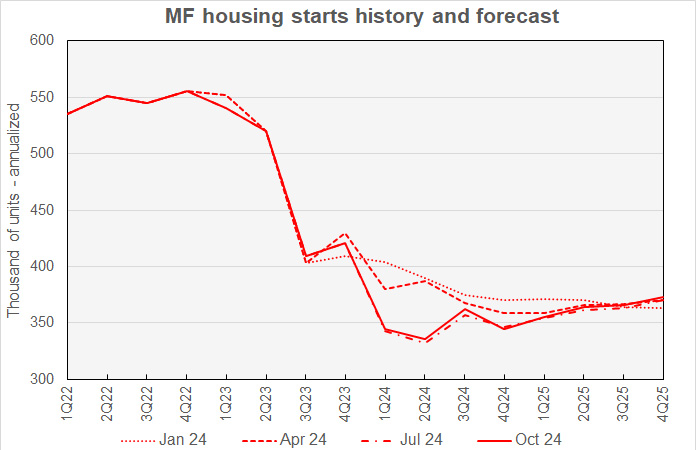
The revisions to Fannie Mae’s forecasts this month were small compared to the changes made in other recent forecasts. The forecasters revised starts in 2024 slightly higher while they revised starts in 2025 slightly lower. No quarterly revision changed the forecast by more than 7,000 units on an annualized rate.
The low point for multifamily starts is still seen as being in Q2 2024 at 336,000 annualized units. The forecast then calls for starts to bump higher to 362,000 annualized units in Q3 before falling back again in Q4. From that point, starts are predicted to slowly climb through the end of 2025, ending that year at an annualized rate of 373,000 units.
For reference, the most recent new residential construction report from the Census Bureau has multifamily starts running at a seasonally-adjusted annualized rate of 336,000 units in Q2 and 372,000 units through the first two months of Q3 2024. However, revisions to the Q3 data are likely.
Looking at yearly forecasts, the predicted number of multifamily starts for 2024 was revised higher by 2,000 units to 347,000 units. The forecast for multifamily starts in 2025 was revised lower by 4,000 units to 364,000 units.
Single-family starts forecast revised upward
The current forecast for single-family housing starts is shown in the next chart, below, along with three other recent forecasts.
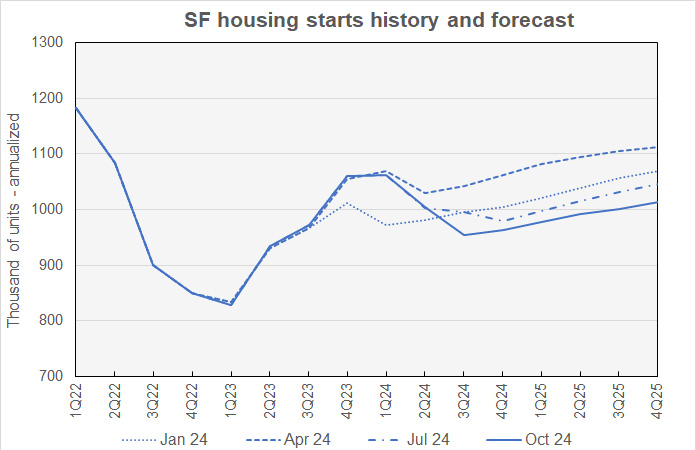
For the first time since the April report, the single-family starts projection was revised higher in this month’s forecast. However, no quarterly forecast was revised by more than 8,000 units on an annualized basis. Despite the increase, the current forecast remains lower than that from July, the most recent forecast shown in the chart.
The low point for single-family starts is expected to be in Q3 2024 at 955,000 annualized units. Single-family starts are then forecast to rise gradually, reaching 1,014,000 annualized units in Q4 2025.
Looking at full-year predictions, Fannie Mae now expects single-family starts to be 996,000 units in 2024, up 3,000 units from the level forecast last month. Single-family starts in 2025 are forecast to also be 996,000 units, up 7,000 units from the level forecast last month.
GDP growth outlook revised higher
The next chart, below, shows Fannie Mae’s current forecast for Gross Domestic Product (GDP) growth, along with other recent forecasts.
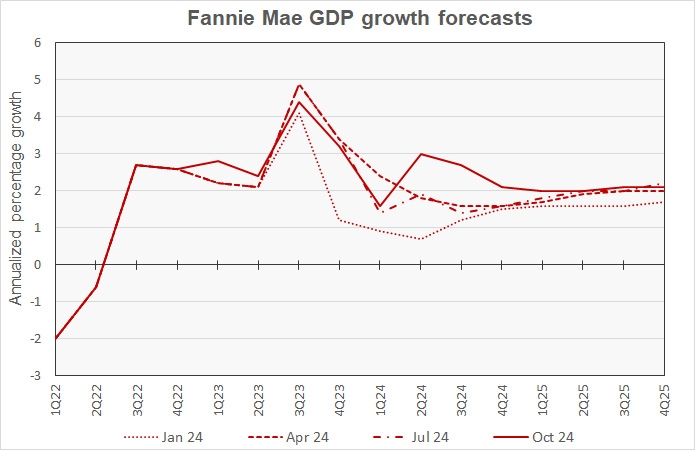
The October forecast for Q3 2024 GDP growth was revised higher again this month, climbing 0.6 percentage points to 2.7 percent at a seasonally adjusted annualized rate. The Q4 forecast was also revised sharply higher, jumping 0.7 percentage points to 2.1 percent. The Q1 2025 forecast was revised upward by 0.4 percentage points while the other quarterly forecasts for 2025 were revised 0.1 to 0.2 percentage points higher.
The low point in the annualized rate of GDP growth is now expected to be in Q1 and Q2 2025, with a rate of 2.0 percent. The annualized rate of GDP growth is predicted to tick higher in Q3 and Q4 2025, reaching a rate of 2.1 percent.
The full year forecast for GDP growth for 2024 was raised 0.3 percentage points to 2.3 percent while the full-year forecast for 2025 was raised 0.2 percentage points to 2.0 percent.
PCE Inflation forecasts mostly lower
The next chart, below, shows Fannie Mae’s current forecast for the chained personal consumption expenditures (PCE) inflation rate, along with three other recent forecasts.
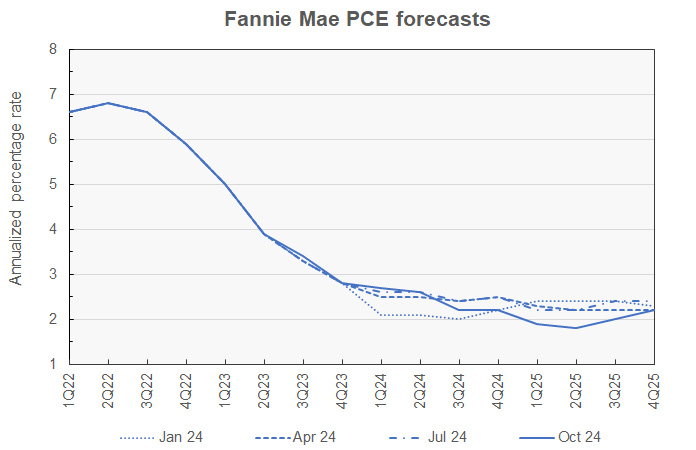
Revisions to the inflation forecasts are typically small and that was the case with this month’s report. No quarter saw its forecasted inflation level change by more than 0.1 percentage point. The inflation forecasts for Q3 2024 through Q1 2025 were all lowered by 0.1 percentage point while that for Q4 2025 was raised by 0.1 percentage point.
PCE inflation is expected to break the Fed’s target rate of 2.0 percent in Q1 2025 and to reach a low point of 1.8 percent in Q2. However, it is predicted to rise above the target by Q4 2025.
Looking at whole-year forecasts, the forecast for year-over-year PCE inflation in Q4 2024 was lowered 0.1 percentage points to 2.2 percent. The Q4 2025 year-over-year inflation forecast was raised 0.1 percentage points to 2.2 percent.
Employment growth forecast slightly lower
The next chart, below, shows Fannie Mae’s current forecast for employment growth, along with three earlier forecasts. Employment growth is our preferred employment metric since job gains, along with productivity gains, drive economic growth. By contrast, the unemployment rate depends on employment but also on the labor force participation rate. Either rising employment or falling labor force participation can drive the unemployment rate lower, but only the former would contribute to economic growth.
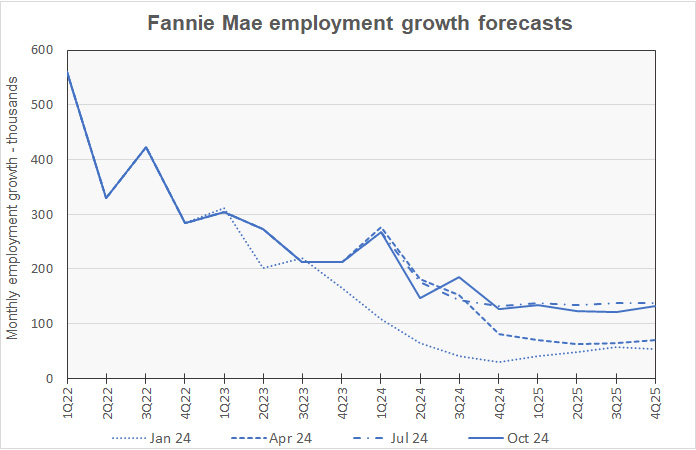
Revisions to this month’s quarterly employment growth forecasts are all to the upside. Monthly job growth is expected to move higher in Q3 2024 but then cool rapidly in Q4. It will not hit its low point until Q3 2025, when it is forecast to be 121,000 jobs per month. It is then forecast to end the year at a level of 132,000 jobs per month in Q4 2025.
For reference, the business survey in the Employment Situation Report from the Bureau of Labor Statistics indicates that the economy added an average of 186,000 jobs per month in Q3 2024.
Compared to last month’s forecast, the expected full year forecast for employment growth in 2024 was revised higher by 300,000 jobs while employment growth for 2025 was revised higher by 100,000 jobs. Employment growth in 2024 is expected to be 2,200,000 jobs. Employment growth in 2025 is expected to be 1,500,000 jobs.
The Fannie Mae October forecast can be found here. There are links on that page to the detailed forecasts and to the monthly commentary.













